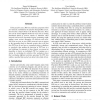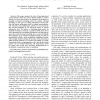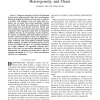548 search results - page 59 / 110 » Secure peer sampling |
CORR
2010
Springer
13 years 10 months ago
2010
Springer
In the past few years, IRC bots, malicious programs which are remotely controlled by the attacker through IRC servers, have become a major threat to the Internet and users. These ...
TON
2012
12 years 11 days ago
2012
—While many attacks are distributed across botnets, investigators and network operators have recently identified malicious networks through high profile autonomous system (AS) ...
CSFW
2011
IEEE
12 years 9 months ago
2011
IEEE
—This paper explores the idea of knowledge-based security policies, which are used to decide whether to answer queries over secret data based on an estimation of the querier’s ...
INFOCOM
2005
IEEE
14 years 3 months ago
2005
IEEE
— Numerous proposals exist for load balancing in peer-to-peer (p2p) networks. Some focus on namespace balancing, making the distance between nodes as uniform as possible. This te...
SP
1998
IEEE
14 years 2 months ago
1998
IEEE
A strand is a sequence of events; it represents either the execution of legitimate party in a security protocol or else a sequence of actions by a penetrator. A strand space is a ...



